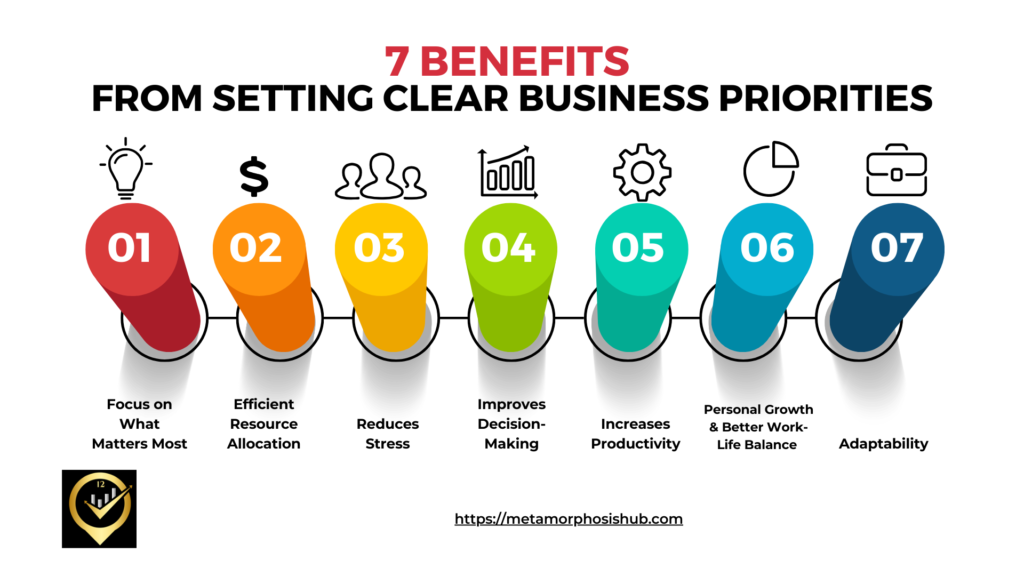Setting objectives is an important aspect of running a small business effectively. Knowing how to set objectives for your small business is another matter entirely!
Objectives are essentially specific, measurable, achievable, relevant, and time-bound (SMART) goals or priorities that guide a business towards its desired outcomes. These goals provide a clear direction, helping businesses focus their efforts and resources on what truly matters.
Whether short-term or long-term, objectives serve as the roadmap for success, allowing business owners to track progress and make informed decisions.
Importance of Setting Objectives in Small Businesses

Setting objectives is more than just good practice. It is a fundamental necessity. There are at least 5 reasons why they are important. They:
Provide Direction: Objectives give a small business a sense of direction, ensuring that everyone within the organization is aligned with common goals and focused on what matters most. This unity of purpose helps streamline efforts toward a shared vision.
Facilitate Decision-Making: Clear objectives act as decision-making criteria. When faced with choices, business owners can refer to their objectives to determine which options align best with the overall strategy and goals of the company.
Measure Progress: Objectives provide measurable targets against which progress can be tracked. This allows businesses to assess their performance regularly and make adjustments as needed. This adaptability promotes continuous improvement.
Motivate and Engage: Employees are more motivated and engaged when they understand the purpose behind their work. Objectives create a sense of purpose and achievement, fostering a positive and productive work environment. It also opens up areas for personal growth.
Allocate Resources Effectively: Limited resources are a common challenge for small businesses. Setting objectives help prioritize resource allocation, ensuring that time, money, and manpower are focused on activities that contribute directly to the business’s success.
Overview of the Role of Objectives in Business Planning
Objectives are the foundation upon which the entire business plan is built. They provide a sense of purpose, a roadmap for success, and a means of adapting to the ever-changing business environment.
Objectives play a key role in the broader spectrum of business planning as they provide guidance from the definition of the business mission and vision through to the creation of action plans.
Define Mission and Vision: Objectives stem from a business’s mission and vision. The mission outlines the company’s purpose, while the vision provides a glimpse of where the business aspires to be in the future.
Conduct SWOT Analysis: Objectives are developed from a thorough analysis of business’s strengths, weaknesses, opportunities, and threats (SWOT). This analysis helps businesses set realistic and relevant objectives that leverage their strengths and address weaknesses.
Establish Clear Strategies: Objectives guide the development of strategies to achieve them. These strategies outline the approaches and actions necessary to reach the defined objectives within the given timeframe.
Create Action Plans: Breaking down objectives into actionable steps is necessary. These action plans detail the specific tasks, responsibilities, and timelines necessary to achieve each objective.
3 – Step Process for Setting Business Objectives
Step 1: Conduct a SWOT Analysis
Identify Strengths, Weaknesses, Opportunities, and Threats
Before setting business objectives, you must conduct a comprehensive SWOT analysis. This involves:
- Strengths: Identifying internal attributes and capabilities that give the business a competitive advantage.
- Weaknesses: Recognizing internal limitations or areas where improvement is needed.
- Opportunities: Evaluating external factors that could positively impact the business.
- Threats: Assessing external factors that pose potential challenges or risks.
Conducting a SWOT analysis requires certain skills, and most small business owners generally gloss over the exercise. Unfortunately, this is a key component for setting business objectives. Seek professional assistance if necessary instead of banging your head against a wall! BCINC will help. Contact us for a chat TODAY
Align Objectives with Your SWOT Findings
Once the SWOT analysis is complete, the next step is to align objectives with the findings:
- Leverage Strengths: Capitalize on the identified strengths to maximize the business’s competitive edge.
- Address Weaknesses: Objectives should aim to mitigate or overcome weaknesses, ensuring a more robust internal structure.
- Exploit Opportunities: Objectives should align with opportunities, enabling the business to tap into external factors for growth.
- Mitigate Threats: Include strategies to address and minimize potential threats, enhancing the business’s resilience.
Step 2: Involve Stakeholders
Importance of Collaboration in Objective Setting
Setting business objectives is not a solitary endeavor; it requires collaboration and input from various stakeholders. The importance of involving stakeholders includes:
- Diverse Perspectives: Stakeholders bring diverse perspectives and insights, enriching the objective-setting process with a broader range of ideas.
- Increased Commitment: Involving key players fosters a sense of ownership and commitment to the objectives, as individuals feel their input is valued.
- Comprehensive Understanding: Stakeholders contribute to a more comprehensive understanding of the business environment, ensuring that objectives are well-informed and realistic.
Gather Input from Key Players
Actively engage stakeholders in the objective-setting process by conducting collaborative workshops or meetings where stakeholders can openly discuss and contribute their thoughts on business objectives.
Use surveys or other feedback mechanisms to gather input from a broader range of stakeholders, including employees, customers, and business partners.
Step 3: Prioritize Your Objectives
Keep in mind that not all objectives are created equal, and prioritization is key. Use these factors to rank and guide your prioritization:
- Impact on Business Goals: Evaluate how each objective contributes to overarching business goals and the overall mission.
- Resource Requirements: Assess the resources, including time, money, and manpower, needed to achieve each objective.
- Time Sensitivity: Determine the urgency of each objective and whether it aligns with short-term or long-term goals.
Ensure that you strike a balance between short-term and long-term objectives by reviewing
- Immediate Gains vs. Sustainable Growth: Always prioritize short-term objectives that yield quick wins while ensuring they align with long-term strategies for sustained growth.
- Resource Allocation: There is no point setting objectives that you cannot allocate resources because you just do not have the necessary resources! Therefore check to see that you are able to allocate resources to ensure that both short-term and long-term objectives receive the attention and resources they require.
Conclusion
In conclusion, the process of setting business objectives involves a strategic and collaborative approach, integrating internal and external insights to create a roadmap for success. The subsequent sections will delve into the implementation and monitoring of these objectives to ensure ongoing business success.
Related Articles
- How to Use SMART Criteria to set Objectives – Small Business
- How to Define Business Objectives – Short Term and Long Term
References
GOC. Writing SMART Objectives. https://www.canada.ca/en/environment-climate-change/services/environmental-funding/tools-for-applying/writing-smart-objectives.html

